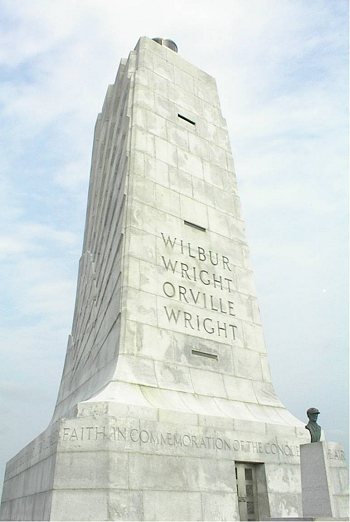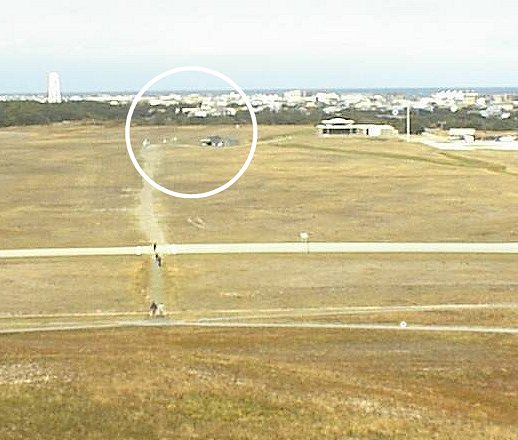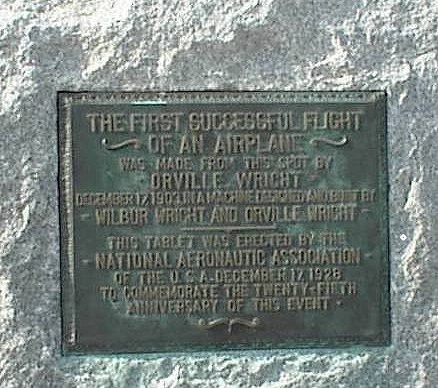 Photo Essay: The Wright
Brothers National Park, Kill Devil Hills, NC
Photo Essay: The Wright
Brothers National Park, Kill Devil Hills, NCby Len Roberto
 Photo Essay: The Wright
Brothers National Park, Kill Devil Hills, NC
Photo Essay: The Wright
Brothers National Park, Kill Devil Hills, NC
by Len Roberto
Anyone interested in aviation history (surely that includes most modelers!) should be drawn to the sandy dunes of Kill Devil Hills, North Carolina at least once in their life. It was there on December 17, 1903 that the Wright Brothers achieved the first flight in a heavier-than-air, powered machine. With all due respect to the supporters of Gustav Whitehead, the Wright Brothers National Park established in 1928 serves as a Mecca for those captivated by the mysteries of flight.
I visited this site on November 20, 2001 and offer these pictures for your enjoyment. The park is open year-round and is well worth a visit if you are staying on the Outer Banks of North Carolina. As if to illustrate to me why the brothers chose this spot to make history, Mother Nature whipped up a steady 30-knot wind across the field proving why the sand and wind were ideal for flight tests. After a quick trip to the visitor’s center, I made my way out to see the actual site of the first flights and the famous stone monument atop the Big Kill Devil Hill.
I am still overwhelmed by the progress made in less than 100 years that man has built machines to carve through the clouds. When you stand atop the big hill looking down on what must have been a desolate, uninhabited landscape for the Wright Brothers, you also are amazed at the dedication Wilbur and Orville exhibited in withstanding 4 ˝ years of trials and tests to reach history.
 The Park is dominated by the massive sand dune created by the wind and sand that
the brothers coined “Big Kill Devil Hill.” The National Park Service long ago
planted a type of grass on the hill to prevent it from eroding. One tour guide
I spoke with said the wind can change the shape of the dunes very rapidly- four
feet of sand has been blown off the beaches farther up the Outer Banks just this
summer and fall. It is quite a walk up the
hill (no kidding! Your editor was a bit
winded by the time he reached the top during his visit.) but when you reach
the summit- you are rewarded with a spectacular view and a majestic stone
monument. The monument commemorates the site where the Wright Brothers launched
hundreds of glider flights from 1900-1902. The Ohio bicycle mechanics had
studied all of the available aeronautical data compiled by fellow visionaries
from Leonardo da Vinci to Samuel Langley. They realized that before power could
be employed, they had to unlock the secrets of controlling a machine in flight.
The story of their failures and successes over three year’s of testing is worth
investigating. The monument is meant to evoke the wings of a bird and chiseled
onto the far side are the names of the brothers as well as a message praising
their achievement.
The Park is dominated by the massive sand dune created by the wind and sand that
the brothers coined “Big Kill Devil Hill.” The National Park Service long ago
planted a type of grass on the hill to prevent it from eroding. One tour guide
I spoke with said the wind can change the shape of the dunes very rapidly- four
feet of sand has been blown off the beaches farther up the Outer Banks just this
summer and fall. It is quite a walk up the
hill (no kidding! Your editor was a bit
winded by the time he reached the top during his visit.) but when you reach
the summit- you are rewarded with a spectacular view and a majestic stone
monument. The monument commemorates the site where the Wright Brothers launched
hundreds of glider flights from 1900-1902. The Ohio bicycle mechanics had
studied all of the available aeronautical data compiled by fellow visionaries
from Leonardo da Vinci to Samuel Langley. They realized that before power could
be employed, they had to unlock the secrets of controlling a machine in flight.
The story of their failures and successes over three year’s of testing is worth
investigating. The monument is meant to evoke the wings of a bird and chiseled
onto the far side are the names of the brothers as well as a message praising
their achievement.
 Looking back down the glide
path, you can see the area where the first powered flights took place. I walked
back down to this area next. The brothers set up a rail in the sand on level
ground and built a small “truck” to attach to their 1903 machine. This was to
provide the underpowered machine a smooth runway to gather enough speed to leap
into the air. On December 14, 1903- the brothers were ready to go. Wilbur won
the coin flip but on his first try, a blast of wind sent the craft out of
control and into the sand just a few feet from the rail. They did not consider
this
Looking back down the glide
path, you can see the area where the first powered flights took place. I walked
back down to this area next. The brothers set up a rail in the sand on level
ground and built a small “truck” to attach to their 1903 machine. This was to
provide the underpowered machine a smooth runway to gather enough speed to leap
into the air. On December 14, 1903- the brothers were ready to go. Wilbur won
the coin flip but on his first try, a blast of wind sent the craft out of
control and into the sand just a few feet from the rail. They did not consider
this  attempt worthy and
decided to make repairs and try again. The wind would not cooperate again until
the 17th.
attempt worthy and
decided to make repairs and try again. The wind would not cooperate again until
the 17th.
On that day, it was Orville’s turn and the rest was history. The stone slab marks the launch point and the rail is still in the ground (not sure if it is the original). Four successful flights were made that day indicated by the markers that you can see in the photo above. The last flight lasted almost a minute and about 860 feet. Diagrams and maps mark the course of the flights in more detail. I tried to imagine the emotions of the day. After 4 ˝ years of work, on that cold day in 1903, the Wrights flew in a machine that they made along with the engine and propeller to push it along. On the last flight of the day, I imagined them with huge grins and probably shouts of incredible joy during that historic minute of flight.